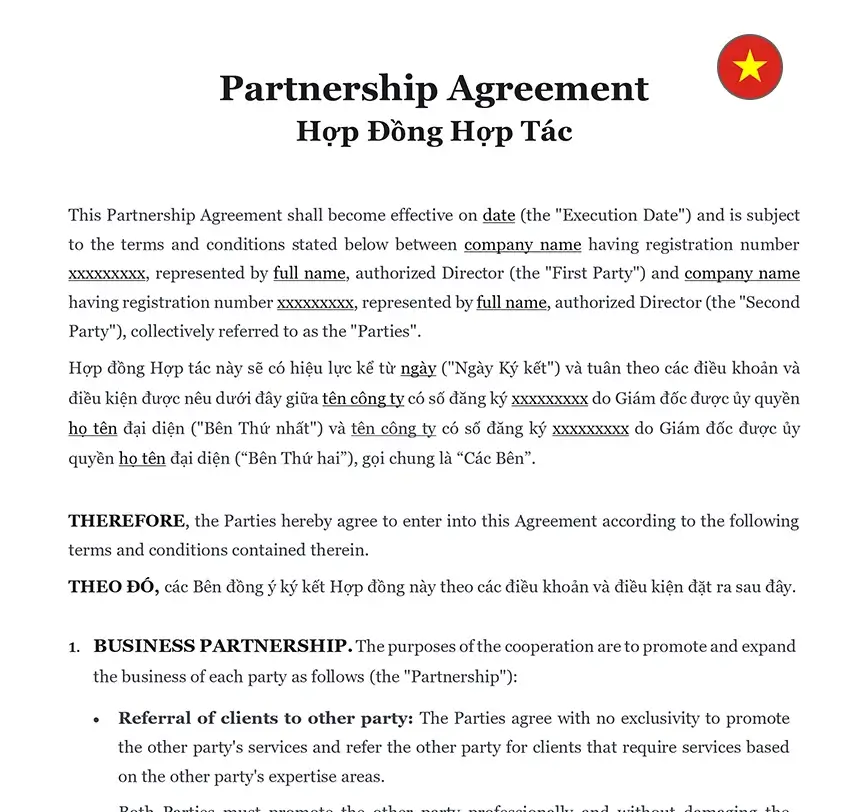Ready to use legal template
Drafted by experienced lawyers
Vietnamese-English translation
Ready to use legal template
Drafted by lawyers
Vietnamese-English translation
Home › Business contracts › Partnership agreement
Learn more about Partnership Agreement in Vietnam
A Partnership Agreement is a legally binding contract between two or more individuals or entities who agree to operate a business together and share its profits, responsibilities, and liabilities. In Vietnam, having a clear and well-drafted Partnership Agreement is essential to avoid misunderstandings, define each partner’s roles, capital contributions, and decision-making authority, and ensure compliance with the Enterprise Law. This document is particularly important for foreign and local investors who wish to form partnerships in Vietnam and need a structured legal framework to govern their collaboration. Download our Partnership Agreement, easy to edit in Word format, drafted by experts in both English and Vietnamese to suit your business in Vietnam.
Table of contents
What is a Partnership Agreement?
What is included in a Partnership Agreement?
What happens if there is no Partnership Agreement?
What are the different types of partnerships in Vietnam?
How does it differ from a Memorandum of Understanding (MOU)?
Can a Partnership Agreement specify how partners can exit the partnership?
Are there any specific requirements for a Partnership Agreement to be valid?
How is it different from a Joint Venture Agreement in Vietnam?
Can it outline the process for admitting new partners into the partnership?
What is a Partnership Agreement?
A Partnership Agreement is a formal legal document that defines the relationship between partners in a business venture. It outlines each partner’s responsibilities, rights, and obligations within the partnership, including the distribution of profits and losses, decision-making processes, management roles, and dispute resolution procedures. This agreement serves as a roadmap for the partnership, ensuring that all partners are on the same page and that the business operates smoothly.
Additionally, a Partnership Agreement can help protect the partners’ interests by specifying how certain situations, such as the admission of new partners or the dissolution of the partnership, will be handled. By clearly outlining these terms in advance, the agreement can prevent potential disagreements and disputes, thereby safeguarding the partnership’s longevity and success.
What is included in a Partnership Agreement?
A Partnership Agreement typically includes several key elements to define the terms and conditions of the partnership. These elements often include:
1. Partnership Details:
The agreement will specify the name of the partnership, its purpose, and its principal place of business.
2. Partners’ Contributions:
It will outline each partner’s contribution to the partnership, whether in the form of capital, assets, or services.
3. Profit and Loss Distribution:
The agreement will specify how profits and losses will be allocated among the partners.
4. Management and Decision Making:
It will detail how the partnership will be managed, including the decision-making processes and the roles and responsibilities of each partner.
5. Admission and Withdrawal of Partners:
The agreement may outline the process for admitting new partners into the partnership and the procedure for partners to withdraw or retire from the partnership.
6. Dispute Resolution:
It will specify how disputes among partners will be resolved, including whether mediation, arbitration, or litigation will be used.
7. Dissolution:
The agreement may include provisions for the dissolution of the partnership, including how assets will be distributed and liabilities settled upon dissolution.
8. Non-compete and Confidentiality:
It may include provisions to prevent partners from competing with the partnership or disclosing confidential information.
9. Tax and Financial Matters:
The agreement may address tax matters, such as how taxes will be handled and whether the partnership will elect for special tax treatment.
10. Duration and Amendments:
Finally, the agreement may specify the duration of the partnership and outline the process for amending the agreement in the future.
What happens if there is no Partnership Agreement?
If there is no Partnership Agreement in place, the partnership will be governed by the default rules and regulations of the jurisdiction in which it operates. This means that the partnership will be subject to the general partnership laws of that jurisdiction, which may not necessarily reflect the intentions or desires of the partners.
Without a Partnership Agreement, several key issues may arise:
1. Profit and Loss Distribution
The default rule may be an equal distribution of profits and losses among partners, regardless of their actual contributions or agreements among themselves.
2. Decision Making
In the absence of an agreement specifying how decisions will be made, each partner may have an equal say in the management of the partnership, which can lead to disagreements and inefficiencies.
3. Management and Responsibilities
Without a clear agreement, the default rules may not accurately reflect the roles and responsibilities that the partners intended.
4. Dispute Resolution
Without a specified dispute resolution mechanism, disputes among partners may escalate, leading to potential legal battles that can be costly and time-consuming.
5. Dissolution
In the event of dissolution, the default rules may not address how assets and liabilities should be distributed, potentially leading to disputes among partners or unfair outcomes.
What are the different types of partnerships in Vietnam?
In Vietnam, there are several types of partnerships that businesses can form, each with its own characteristics and legal requirements. The main types of partnerships in Vietnam include:
Unlimited Liability Partnership (ULP): This type of partnership is similar to a general partnership, where all partners have unlimited personal liability for the debts and obligations of the partnership.
Limited Liability Partnership (LLP): In an LLP, at least one partner has unlimited liability while others have limited liability up to the amount they have contributed to the partnership.
Partnership with Two or More Members (TP): This is a type of partnership where partners share profits and losses according to the agreement, but their liability is limited to the amount of capital they have contributed.
Partnership for Small and Medium Enterprises (SME): This type of partnership is designed for small and medium-sized enterprises and has simplified registration and reporting requirements.
Partnership in Law Practice (LP): This type of partnership is specifically for law practitioners and is subject to specific regulations governing legal practices.
Partnership in Medicine Practice (MP): Similarly, this type of partnership is for medical practitioners and is subject to specific regulations governing medical practices.
Professional Partnership (PP): This type of partnership is for professionals such as lawyers, doctors, architects, and accountants, who are allowed to practice their professions collectively.
Each type of partnership has its own set of rules and regulations governing its formation, operation, and dissolution, so it’s important for businesses to carefully consider their options and choose the most appropriate type of partnership for their needs.
How does it differ from a Memorandum of Understanding (MOU)?
A Partnership Agreement and a Memorandum of Understanding (MOU) serve different purposes and have distinct characteristics:
1. Purpose
| ➤ Partnership Agreement: It is a legally binding document that outlines the terms and conditions of a partnership, including profit-sharing, decision-making, and dispute resolution. |
| ➤ Memorandum of Understanding (MOU): It is a non-binding agreement that outlines the intentions of parties to enter into a formal agreement or partnership. It is often used as a preliminary step to formalizing a partnership or to outline the broad terms of cooperation between parties. |




